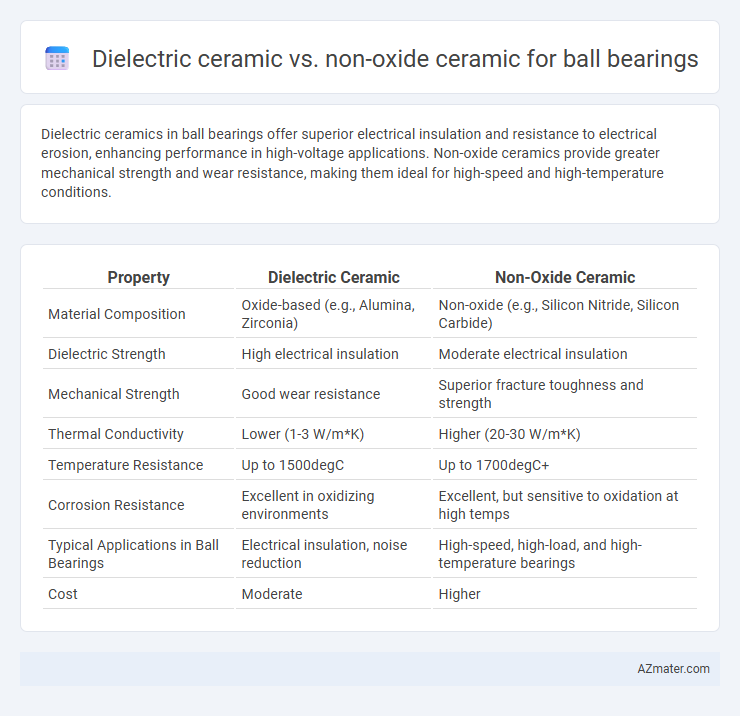Dielectric ceramics in ball bearings offer superior electrical insulation and resistance to electrical erosion, enhancing performance in high-voltage applications. Non-oxide ceramics provide greater mechanical strength and wear resistance, making them ideal for high-speed and high-temperature conditions.
Table of Comparison
| Property | Dielectric Ceramic | Non-Oxide Ceramic |
|---|---|---|
| Material Composition | Oxide-based (e.g., Alumina, Zirconia) | Non-oxide (e.g., Silicon Nitride, Silicon Carbide) |
| Dielectric Strength | High electrical insulation | Moderate electrical insulation |
| Mechanical Strength | Good wear resistance | Superior fracture toughness and strength |
| Thermal Conductivity | Lower (1-3 W/m*K) | Higher (20-30 W/m*K) |
| Temperature Resistance | Up to 1500degC | Up to 1700degC+ |
| Corrosion Resistance | Excellent in oxidizing environments | Excellent, but sensitive to oxidation at high temps |
| Typical Applications in Ball Bearings | Electrical insulation, noise reduction | High-speed, high-load, and high-temperature bearings |
| Cost | Moderate | Higher |
Introduction to Ceramic Materials in Ball Bearings
Dielectric ceramics, such as alumina and zirconia, offer excellent electrical insulation and high hardness, making them suitable for ball bearings in electrically sensitive applications. Non-oxide ceramics, including silicon nitride and silicon carbide, provide superior mechanical strength, wear resistance, and thermal stability, enhancing bearing performance under high-speed and high-temperature conditions. Selecting between dielectric and non-oxide ceramics depends on specific operational demands, such as electrical insulation requirements versus mechanical durability and thermal conductivity.
Overview of Dielectric Ceramics
Dielectric ceramics, primarily composed of materials such as alumina or zirconia, offer exceptional electrical insulation and high mechanical strength critical for ball bearing applications in high-voltage environments. These ceramics provide superior resistance to thermal shock and corrosion compared to non-oxide ceramics, enhancing the reliability and lifespan of bearings in demanding electrical and mechanical systems. Their intrinsic dielectric properties minimize electrical discharge damage, making them ideal for use in precision electric motors and high-frequency applications.
Overview of Non-oxide Ceramics
Non-oxide ceramics, such as silicon nitride and silicon carbide, offer superior hardness, thermal stability, and fracture toughness compared to dielectric ceramics in ball bearing applications. These materials exhibit excellent wear resistance and corrosion resistance, making them ideal for high-speed, high-temperature, and harsh environment conditions. Non-oxide ceramics' low density and high strength-to-weight ratio contribute to reduced bearing weight and enhanced performance in advanced engineering applications.
Key Properties Comparison: Dielectric vs Non-oxide Ceramics
Dielectric ceramics like alumina and zirconia offer high electrical insulation, excellent corrosion resistance, and stable performance at elevated temperatures, making them ideal for ball bearings in electrically sensitive applications. Non-oxide ceramics such as silicon nitride and silicon carbide provide superior fracture toughness, higher thermal conductivity, and enhanced wear resistance, suitable for high-speed and high-load bearings. The key property comparison reveals dielectric ceramics excel in electrical insulation and chemical stability, while non-oxide ceramics outperform in mechanical strength and thermal shock resistance.
Mechanical Strength and Durability Analysis
Dielectric ceramics such as alumina and zirconia offer superior mechanical strength and high fracture toughness, making them highly durable for ball bearing applications under high-stress conditions. Non-oxide ceramics like silicon nitride and silicon carbide provide excellent wear resistance and thermal stability with lower density, enhancing overall mechanical performance and extending service life in demanding environments. Comparative studies show non-oxide ceramics exhibit better fatigue resistance and impact toughness, ensuring longer operational durability than traditional dielectric ceramics in high-speed and high-temperature bearing applications.
Electrical Insulation Capabilities
Dielectric ceramics like alumina and zirconia offer superior electrical insulation capabilities for ball bearings due to their high resistivity and low dielectric loss, preventing electrical current flow and minimizing stray current damage. Non-oxide ceramics such as silicon nitride provide excellent mechanical strength and thermal shock resistance but have comparatively lower electrical insulation properties, which can limit their use in electrically sensitive applications. Choosing dielectric ceramics enhances bearing reliability in electric motors and generators by effectively isolating electrical currents and reducing the risk of electrical erosion.
Performance Under Extreme Conditions
Dielectric ceramics used in ball bearings exhibit superior electrical insulation and thermal stability, making them ideal for high-voltage and high-frequency applications. Non-oxide ceramics, such as silicon nitride, offer exceptional mechanical strength, wear resistance, and thermal shock resistance, ensuring reliable performance under extreme temperatures and harsh environments. The choice between dielectric and non-oxide ceramics depends on the specific operational demands, with non-oxide ceramics often favored for their enhanced durability and longevity in severe conditions.
Wear Resistance and Longevity
Dielectric ceramics such as alumina and zirconia exhibit superior wear resistance and longevity in ball bearings due to their high hardness and chemical stability under frictional stress. Non-oxide ceramics, including silicon nitride and silicon carbide, provide enhanced toughness and thermal shock resistance, contributing to extended bearing life in high-speed and high-temperature applications. Both materials outperform traditional steel bearings, but selection depends on operational environment and specific wear resistance requirements.
Cost-Effectiveness and Manufacturing Aspects
Dielectric ceramics in ball bearings offer superior electrical insulation and thermal stability, often resulting in lower machining costs due to easier processing compared to non-oxide ceramics like silicon nitride or zirconia, which require high-temperature sintering and precision grinding. Non-oxide ceramics provide higher mechanical strength and wear resistance but involve more complex manufacturing steps, increasing overall production expenses. Cost-effectiveness favors dielectric ceramics for applications prioritizing insulation and moderate durability, while non-oxide ceramics justify higher costs through enhanced performance in demanding environments.
Applications and Suitability for Ball Bearings
Dielectric ceramics such as zirconia and alumina offer excellent electrical insulation and superior hardness, making them ideal for high-speed ball bearings in electric motors and precision instruments where non-conductivity is crucial. Non-oxide ceramics like silicon nitride provide exceptional toughness, wear resistance, and thermal stability, suitable for ball bearings in demanding environments such as aerospace, automotive, and high-temperature machinery. Choosing between dielectric and non-oxide ceramics depends on specific application requirements, including electrical insulation needs, mechanical stress, and operating temperature conditions.

Infographic: Dielectric ceramic vs Non-oxide ceramic for Ball bearing
 azmater.com
azmater.com